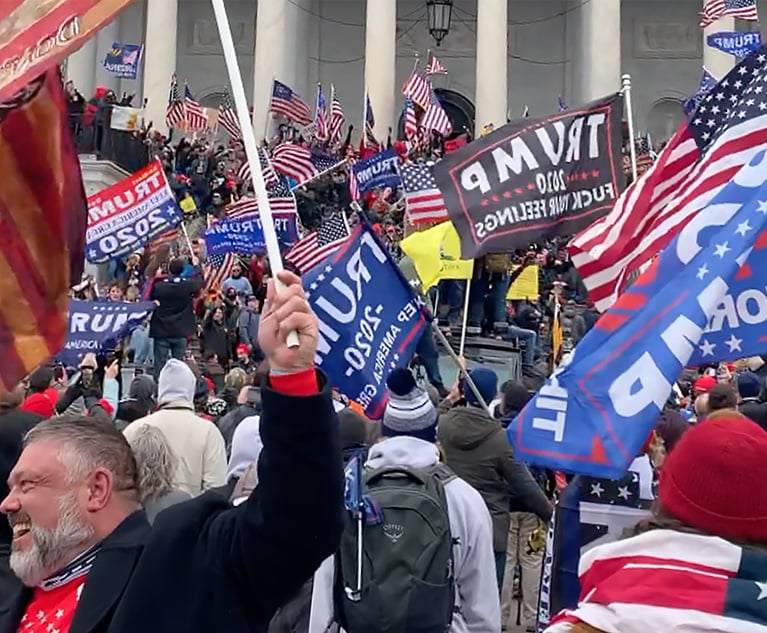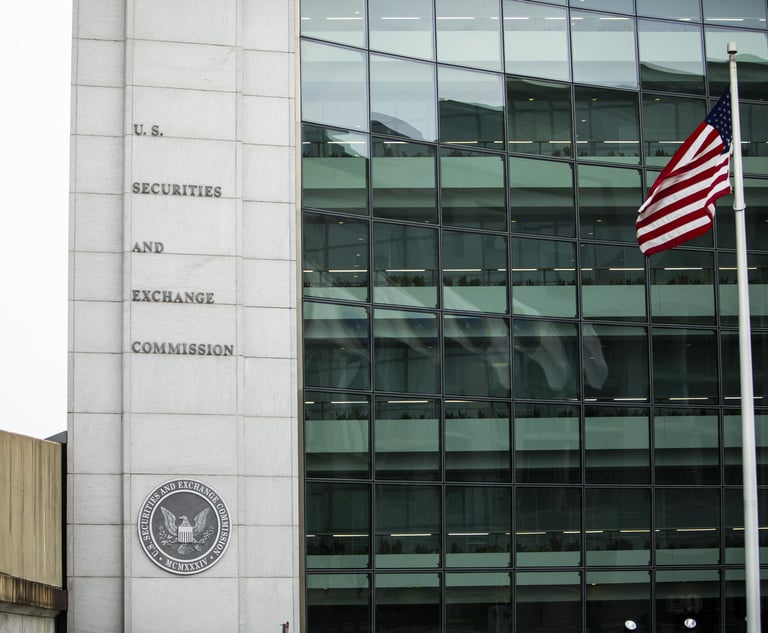A Challenge to New Joint Employer Rules
In this Employment Issues column, Philip M. Berkowitz discusses joint employer status and a number of recent changes on the issue, the upshot of which may be to reduce the number of federal employment related lawsuits and draw more of these claims into state courts, where the laws may be more favorably disposed toward employees, contractors, consultants, and similar workers.
March 11, 2020 at 12:45 PM
9 minute read
 Philip M. Berkowitz
Philip M. Berkowitz
On Jan. 20, 2020, the Trump Administration's Department of Labor issued new rules on joint employer status that will make it far more difficult for contractors and consultants to sue the companies for whom they provide services over alleged violations of the Fair Labor Standards Act, which mandates payment of minimum wage and overtime to employees.
New York, California, and 18 other states and the District of Columbia swiftly filed a lawsuit in the Southern District of New York challenging the rules' legality, asserting that the DOL's actions were arbitrary and capricious, an abuse of discretion, and contrary to law. New York v. Scalia, Case No. 1:20-cv-01689 (S.D.N.Y. filed Feb. 26, 2020).
The issue of joint employer liability is particularly important—not only in the context of overtime lawsuits, but also as employers face sex harassment and discrimination lawsuits, and potential union organizing, from contractors and consultants.
As the gig economy has grown and employers add contractors to their workforce, many contractors and consultants sue the companies that retain their services for unpaid wages, even where the services are contracted through a staffing agency. The workers argue that they are jointly employed both by the staffing agency that refers them to the contracting employer and by the employer itself, and that both bear liability under the law.
The Trump Administration is working to limit the application of this theory—not only in the context of wage payments, but in other related areas.
Thus, on February 14, the National Labor Relations Board issued its own rule, similarly narrowing the definition of joint employer, but this time under the National Labor Relations Act. This rule will make it more difficult for unions to organize consultants who are retained by companies through staffing agencies.
We expect a similar rule from the EEOC, which would limit the right of contractors to sue the entity for which they are performing services, for alleged discrimination, harassment and retaliation.
As discussed further below, the upshot of these changes may be to reduce the number of federal employment related lawsuits, and draw more of these claims into state courts, where the laws may be more favorably disposed toward employees, contractors, consultants, and similar workers.
The Changes
Case law and regulations developed over the past century, since the FLSA's passage in 1938, define when two companies are considered joint employers of the same employee. Congress last revised these regulations, at 29 C.F.R. Part 791, in 1961, 59 years ago.
The new FLSA regulations impose a relatively narrow, four-factor test for determining joint employment under the FLSA. The DOL will consider whether the potential joint employer actually exercises the power to:
- hire or fire the employee;
- supervise and control the employee's work schedules or conditions of employment;
- determine the employee's rate and method of payment; and
- maintain the employee's employment records.
Thus, the issue does not depend on whether the contracting employer has the power to engage in the above acts, but whether evidence shows that it actually does so. A company's ability to terminate the individual does not determine the question—rather, the balance shifts only if the company actually exercises that power.
The regulations consider additional factors to determine joint employer status, but only if they are indicative of whether a potential joint employer is exercising significant control over the terms and conditions of the employee's work or otherwise acting directly or indirectly in the interest of the employer in relation to the employee.
The proposed rule purports to clarify factors that are not relevant to the joint employer analysis, most notably explaining that "economic dependence" on the potential joint employer does not determine the potential joint employer's liability.
Other irrelevant factors include, but are not limited to, whether the employee is in a specialty job or a job otherwise requiring special skill, initiative, judgment, or foresight; has the opportunity for profit or loss based on managerial skill; and invests in equipment or materials required for work or the employment of helpers—factors often used to determine whether a worker is an employee or an independent contractor.
Thus, the rules provide that the question of whether a worker is an employee at all—the independent contractor inquiry—is separate from the question of who are the employers of an employee.
This is further clarified by language providing that, contrary to earlier interpretations, the definition of "employ" in the FLSA as "to suffer or permit work" does not control the issue. This means that the mere fact that an individual works for a particular employer does not render the individual an employee.
The FLSA defines "employer" as including "any person acting directly or indirectly in the interest of an employer in relation to an employee." Thus, the proposed rule states that indirect action in relation to an employee may, in some cases, also establish joint employer status.
The new rule also adds language on the impact of contractual obligations and business models. For example, operating as a franchisor would not make joint employer status more or less likely; nor would requiring a business partner to institute workplace safety measures, wage floors, or sexual harassment policies.
Finally, the rule states that providing a sample employee handbook to a franchisee, allowing an employer to operate a facility on one's premises, jointly participating with an employer in an apprenticeship program, or offering an association health or retirement plan to the employer or participating in such a plan with the employer, would not create joint employer status.
The Lawsuit
New York v. Scalia, which challenges the new FLSA rules as arbitrary and capricious, is reflective of the counter-effort by many state and local governments to pass laws that seek to blunt the effect of federal laws limiting the rights of individuals in various employment law contexts.
Thus, the New York City Council recently amended the Human Rights Law, effective Jan. 11, 2020, to include freelancers and independent contractors in the category of workers protected by the law's anti-discrimination provisions.
Similarly, the New York state legislature amended the state's Human Rights Law, effective Feb. 8, 2020, to expand that law's protection against discrimination and harassment to include non-employees such as independent contractors, vendors, and consultants.
In New York v. Scalia, the states make a number of claims to support their assertions that the Rules are contrary to law. They note prior Supreme Court and lower court decisions, as well as earlier interpretations by the DOL, which recognized that joint employment may exist when a "lead employer" exerts a significant economic influence over the employee, even if not formal control.
They point to the "economic realities" test, in which courts have historically assessed the nature of the relationship between the employee and the potential joint employer, to determine whether the potential employer has "suffered or permitted" the employee to work.
In particular, they rely upon Rutherford v. McComb, 331 U.S. 722 (1946), in which the Supreme Court found that the FLSA's "definition of 'employee' is broad," and that determining whether an employment relationship exists "does not depend on [] isolated factors but rather upon the circumstances of the whole activity."
In particular, they point out that in recent years, subcontracting, outsourcing, and franchising occur in an increasing variety of industries which practices, they allege, have resulted in wage decreases among workers retained in that manner.
Interestingly, in quantifying the alleged damages that the DOL's implementation of the new FLSA rules will have on them, New York and its co-plaintiffs identify a number of effects the new rules will have.
First, they allege that many of the states have statutory requirements regarding minimum wage and overtime pay that are textually identical or similar to the FLSA. In light of that, they claim, those states will need to retract current guidance that incorporates prior FLSA jurisprudence into discussions of state law standards for determining joint employment.
Other states who have different standards than the FLSA, the plaintiffs allege, will incur costs by issuing new or revised guidance and regulations clarifying distinct state standards and specifying that state law standards governing joint employment continue to apply despite the Final Rule's "unprecedented curtailment of the FLSA's scope."
They also argue that the new rule will require some of the states to incur costs in educating the public about the new rules for joint employment, and to promulgate state regulation or other formal guidance to clarify that the Final Rule's narrowed test for joint employment do not alter the standards under their state laws.
The states also claim that, because the states will increasingly become the preferred venue for claims alleging joint employer liability, the new rule will increase their cost of enforcement. States will be forced to shift enforcement priorities in order to manage their already-limited resources or incur costs by hiring additional investigators, counsel, data analysts, and other staff to properly combat wage theft and enforce state labor standards laws.
Thus, the states recognize that more of these cases will come their way—which is likely an accurate prediction. Despite this, it seems unlikely that states will anytime soon adopt anything like the more restrictive federal legal standards that are likely to drop these cases into the laps of the states.
Philip M. Berkowitz is a shareholder of Littler Mendelson and co-chair of the firm's U.S. international employment law and financial services practices.
This content has been archived. It is available through our partners, LexisNexis® and Bloomberg Law.
To view this content, please continue to their sites.
Not a Lexis Subscriber?
Subscribe Now
Not a Bloomberg Law Subscriber?
Subscribe Now
NOT FOR REPRINT
© 2025 ALM Global, LLC, All Rights Reserved. Request academic re-use from www.copyright.com. All other uses, submit a request to [email protected]. For more information visit Asset & Logo Licensing.
You Might Like
View All
Private Equity Giant KKR Refiles SDNY Countersuit in DOJ Premerger Filing Row
3 minute readLaw Firms Mentioned
Trending Stories
- 1Corporate Litigator Joins BakerHostetler From Fish & Richardson
- 2E-Discovery Provider Casepoint Merges With Government Software Company OPEXUS
- 3How I Made Partner: 'Focus on Being the Best Advocate for Clients,' Says Lauren Reichardt of Cooley
- 4People in the News—Jan. 27, 2025—Barley Snyder
- 5UK Firm Womble Bond to Roll Out AI Tool Across Whole Firm
Who Got The Work
J. Brugh Lower of Gibbons has entered an appearance for industrial equipment supplier Devco Corporation in a pending trademark infringement lawsuit. The suit, accusing the defendant of selling knock-off Graco products, was filed Dec. 18 in New Jersey District Court by Rivkin Radler on behalf of Graco Inc. and Graco Minnesota. The case, assigned to U.S. District Judge Zahid N. Quraishi, is 3:24-cv-11294, Graco Inc. et al v. Devco Corporation.
Who Got The Work
Rebecca Maller-Stein and Kent A. Yalowitz of Arnold & Porter Kaye Scholer have entered their appearances for Hanaco Venture Capital and its executives, Lior Prosor and David Frankel, in a pending securities lawsuit. The action, filed on Dec. 24 in New York Southern District Court by Zell, Aron & Co. on behalf of Goldeneye Advisors, accuses the defendants of negligently and fraudulently managing the plaintiff's $1 million investment. The case, assigned to U.S. District Judge Vernon S. Broderick, is 1:24-cv-09918, Goldeneye Advisors, LLC v. Hanaco Venture Capital, Ltd. et al.
Who Got The Work
Attorneys from A&O Shearman has stepped in as defense counsel for Toronto-Dominion Bank and other defendants in a pending securities class action. The suit, filed Dec. 11 in New York Southern District Court by Bleichmar Fonti & Auld, accuses the defendants of concealing the bank's 'pervasive' deficiencies in regards to its compliance with the Bank Secrecy Act and the quality of its anti-money laundering controls. The case, assigned to U.S. District Judge Arun Subramanian, is 1:24-cv-09445, Gonzalez v. The Toronto-Dominion Bank et al.
Who Got The Work
Crown Castle International, a Pennsylvania company providing shared communications infrastructure, has turned to Luke D. Wolf of Gordon Rees Scully Mansukhani to fend off a pending breach-of-contract lawsuit. The court action, filed Nov. 25 in Michigan Eastern District Court by Hooper Hathaway PC on behalf of The Town Residences LLC, accuses Crown Castle of failing to transfer approximately $30,000 in utility payments from T-Mobile in breach of a roof-top lease and assignment agreement. The case, assigned to U.S. District Judge Susan K. Declercq, is 2:24-cv-13131, The Town Residences LLC v. T-Mobile US, Inc. et al.
Who Got The Work
Wilfred P. Coronato and Daniel M. Schwartz of McCarter & English have stepped in as defense counsel to Electrolux Home Products Inc. in a pending product liability lawsuit. The court action, filed Nov. 26 in New York Eastern District Court by Poulos Lopiccolo PC and Nagel Rice LLP on behalf of David Stern, alleges that the defendant's refrigerators’ drawers and shelving repeatedly break and fall apart within months after purchase. The case, assigned to U.S. District Judge Joan M. Azrack, is 2:24-cv-08204, Stern v. Electrolux Home Products, Inc.
Featured Firms
Law Offices of Gary Martin Hays & Associates, P.C.
(470) 294-1674
Law Offices of Mark E. Salomone
(857) 444-6468
Smith & Hassler
(713) 739-1250









